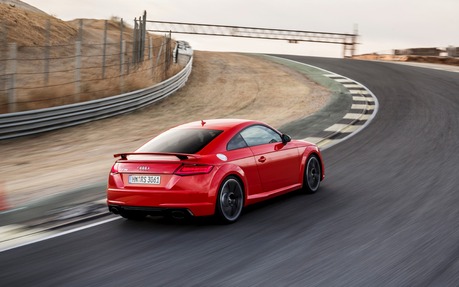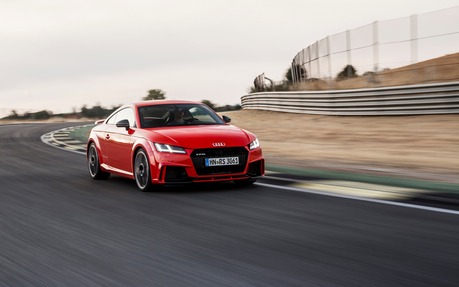[EXCLUSIVE] 2018 Audi TT RS: Five Alive!
CIRCUITO DEL JARAMA, Spain – It’s the sound that’s addictive. The husky, almost staccato sound that the TT RS coupe’s five-cylinder turbo engine made at full throttle on the Circuito del Jarama may as well be a hard drug.
The evocative sound of the inline-five stems from its 1-2-4-5-3 firing sequence: meaning that it fires in alternating order between adjacent cylinders and others that are at a distance from one another. This particular sequence gives this engine a unique tempo, not to mention that quintessential vocal signature.
- Also: 2018 Audi TT RS: We’re Driving it on the Track This Week
- Also: Audi Unveils TT RS Models in Beijing
A lighter and more powerful engine
This inline-five won “International Engine of the Year” in the 2.0 to 2.5 litre category seven years running. For this second-generation TT RS, the brand’s engineers overhauled it completely, giving it an entirely aluminum block and thereby reducing the weight by 26 kg compared to the previous model.
Before hitting the track, I tested the TT RS’s launch control system. It propels the vehicle from 0 to 100 km/h in 3.7 seconds with an extremely sustained thrust, registering 1.2 on the G counter displayed on the screen in Dynamic mode. That figure puts it right in the mix with high-calibre exotic cars. In maximum braking at the end of the straightaway, the massive deceleration was calculated at 1.3 G.

394 horsepower and 354 lb.-ft. of torque
On the Jarama circuit, comprised mainly of tight corners and long straightaways, the 2018 Audi TT RS’s engine is very linear, with a maximum of 354 lb.-ft. of torque that is available and constant from 1700 to 5850 rpm.
At a mere 1440 kg, this car’s handling is incredibly incisive entering turns, thanks to faster steering and lower ground clearance compared to the TTS. In Dynamic mode, the all-wheel drive delivers more torque to the rear wheels coming out of the curve, making the TT RS handle a little more like a rear-drive car when the engine is at full throttle from the apex to the end of a turn.
Even on fast corners, the TT RS coupe proves very stable and its responses are characterized by confidence-inspiring predictability. However, the TT RS is neither as lively nor as exciting on the track as a rear-wheel-drive sports car, but it is nonetheless highly qualified for driving in this specific type of environment. So that’s it for the track, now what about the road?

Adaptive handling
Thanks to the magnetorheological suspension, the TT RS coupe’s handling is adaptive and its Comfort mode helps absorb any unevenness in the road while letting you feel the weight transfer in turns when the ride is more relaxed. That said, I should specify that the quality of the road surface on which I drove was particularly good, so the comfort could be another story back home in Canada.
The 2018 Audi TT RS’s look is distinguished by its three-dimensional, bee’s nest Singleframe grille with the “quattro” logo at the base. A fixed rear spoiler overhangs the trunk and the black-painted exhaust tips indicate a sport exhaust. The Audi virtual cockpit is a mainstay and the passenger compartment looks a lot like the inside of other models in the family, but the diamond-patterned RS Sport seats help the TT RS coupe stand out.
As the TT RS will only be available in the summer of 2017 for the 2018 model year, the brass at Audi wasn’t able to specify its price at the European launch. With the current version of the TTS starting at $62,700, it’s a safe bet that the TT RS will probably go for about $75,000. If that turns out to be the case, the most dynamic version of the TT will be both a faster and less expensive rival to the Porsche 718 Cayman S. Add to that the excellent stability that comes with all-wheel drive when weather conditions take a turn for the worse, and you get a sports car that is a good match for our climate.
| Test drive report | |
| Test model | 2018 Audi TT |
|---|---|
| Trim level | RS Coupe |
| Price range | N/A |
| Price as tested | N/A |
| Warranty (basic) | N/A |
| Warranty (powertrain) | N/A |
| Fuel economy (city/highway/observed) | 11,3 / 6,4 / 11,3 L/100km |
| Options | N/A |
| Competitive models | Alfa Romeo 4C, BMW Z4, Chevrolet Corvette, Jaguar F-TYPE, Lotus Evora, Mercedes-Benz SLC |
| Strong points |
|
| Weak points |
|
| Editor's rating | |
| Fuel economy | Depends entirely on the enthusiasm of the driver, but since the gearbox has seven speeds, fuel consumption is reasonable on the highway. |
| Comfort | Excellent when you select Comfort mode on the very nice roads around Madrid. What will it be like in Canada? |
| Performance | 0 to 100 in 3.7 seconds with 1.2 G in flat-out acceleration. That’s the stuff of a high-calibre exotic car. |
| Infotainment | The Audi’s MMI (Multi Media Interface) system is very user friendly and the virtual cockpit is great. |
| Driving | A pleasure to drive both on the track and on the road. |
| Overall | The Porsche 718 Cayman S will have to contend with a very serious rival. |
